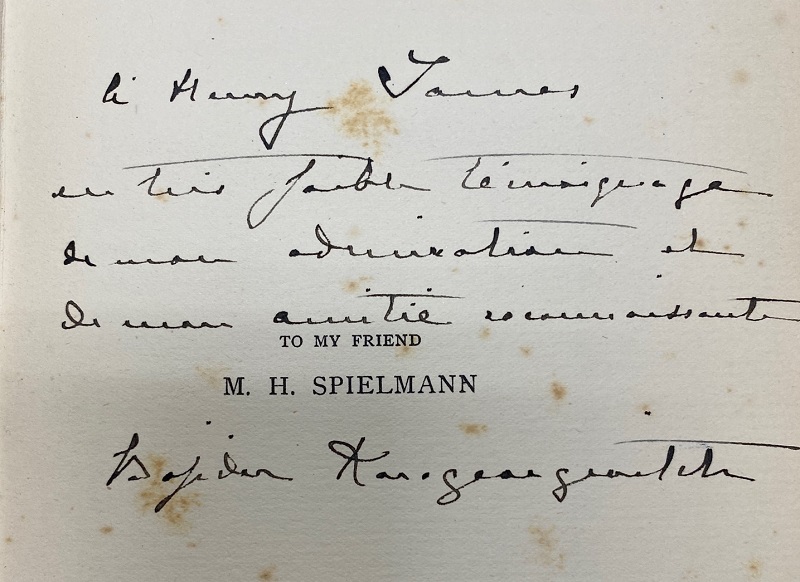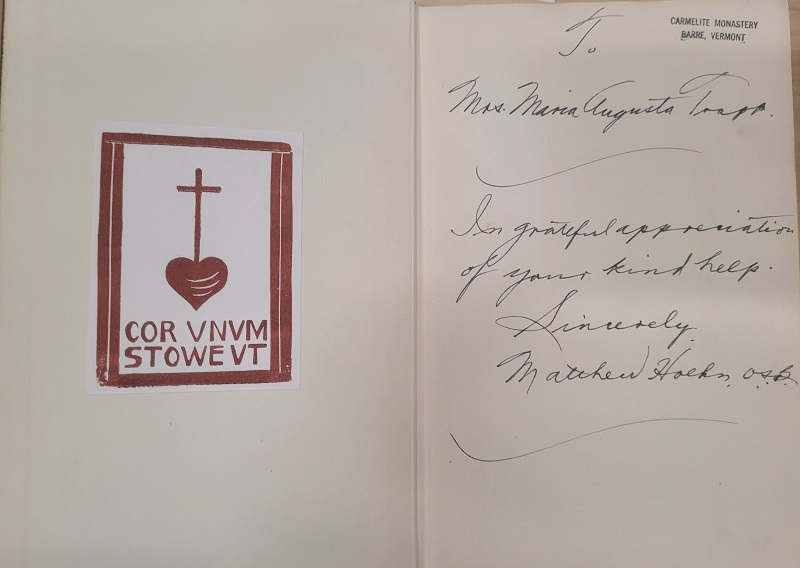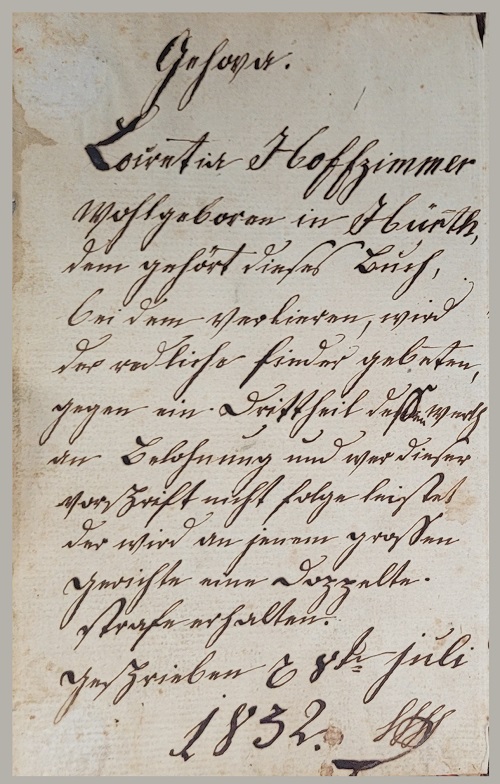University Libraries

Wednesday August 31, 2022
Book History Mystery
By Joan Milligan and Grace Huffman
Most books and manuscripts in University of Dayton Libraries’ special collections are very old — some more than 500 years old. They come to us through special purchases, as parts of collections and by donation. Knowing any previous owners can often tell us much about the book’s history — and even about the owners themselves.
- Maria von Trapp (1905-1987): Catholic Authors: Contemporary Biographical Sketches (1952). This book seems to have been a gift to Trapp from the author. An inscription in the front cover from the author, Matthew Hoehn, thanks her for her help. Then the book was housed in the Trapp library. The bookplate reads: Cor Unum Stowe VT. Cor Unum, Latin for “One Heart,” was the name of the home of the Trapps in Stowe, Vermont. Some time later, the book seems to have been donated to the nearby Carmelite monastery in Barre, Vermont, due to the remaining stamp from its library. The Monastery closed its doors in 1997. The book is now housed in our own U.S. Catholic Special Collection.
- Henry James (1843-1916): Enchanted India (1899). This was apparently a gift to James from the author, an exiled Serbian prince, Bojidar Karageorgevitch, who lived in Paris. Since there is only Karageorgevitch’s inscription, “Henry James: Un tres faible temoignage de mon admiration et de mon amitie reconnaissante” (A very weak testimony of my admiration and my grateful friendship), we cannot be sure that the book belonged to the illustrious author Henry James. However, given that he was fluent in French, traveled to Paris often and had many literary friends, it seems likely. James complained in his letters about having too many books, so it may be that this is one he decided to weed. It is now in the Victor and Irene Jacobs Special Collection, which was created with purchases from many far-flung sources. University Archives and Special Collections.
- William Winter (1836-1917): Henry Irving (1885). Winter was an American drama critic and author — and a friend of Bram Stoker, author of Dracula. A letter from Stoker to Winter was found inside the book, which is tagged with Winter’s bookplate. University Archives and Special Collections.
- Maynard Family of Portland, Maine: Book of Common Prayer (1795). A page sewn into the back lists names and birth dates of members of the Maynard family from 1766 to 1808. At the top is John Maynard, the son of a minuteman who fought at the Battle of Bunker Hill. It notes his marriage to Mary Durant in 1789. The family list continues with nine names over the next 18 years. The last entry, for Cornelia, documents her marriage to Neal Dow, a Quaker. He became mayor of Portland in the 1850s. [Some of the details were found on Ancestry.com.] The book came to us from Maine, a gift from the Diocese of Portland. University Archives and Special Collections.
- Angelico Chavez (1910-1996): Cathecismo de la doctrina christiana, en lengua zaapoteca (1776). This catechism in Spanish and Zapotec was published in Mexico to teach the local indigenous Zapotec-speaking communities about the Catholic faith. About 150 years after its publication, Chavez added it to his library, pasting in his personal bookplate. Chavez was a Hispanic American priest well known for his works of history, poetry and fiction. He seems to have given this book away in 1959, as there is a note on the back of the title page, “gift from [Rm.] Angelico Chavez OFM, 3-10-59.” We do not know who received the book, but it may have been a Dr. J. Armstrong, as a note on the first page tells us of another owner: “To Father Mike from Dr. J. Armstrong, Toronto University.” In 1998, it was added to our collections. Marian Library.
- Juan Inocentes Manco Garcia: Breviarium Romanum: Pars heymalis et pars verna (1798). Garcia was a Franciscan missionary in the Philippines, and his battered book reveals a life of rough travel. Inside the book is a note dated May 31, 1968, from Father Vincent Diekman: “Fr. Harold found it among the effects of the former Spanish pastor and took the much-used volume to the United States, later donating it to St. Leonard College Library.” From there it came to us. University Archives and Special Collections.
Finally, although this book owner lacks fame, she is notable for her vehement feelings for her book.
- Lucretia Hoffzimmer of Hürth: Himmlischer Wegweiser (1826). Hoffzimmer owned this German prayer book and wanted to make sure everyone knew it. She wrote her name inside the front cover, offering a reward should she lose it. If it was found but not returned, she declared that the wrongdoer should expect a double punishment at the Last Judgment. Dated July 8, 1832. Marian Library.
— Joan Milligan and Grace Huffman are special collections catalogers in the University of Dayton Libraries.
Share
Topics


